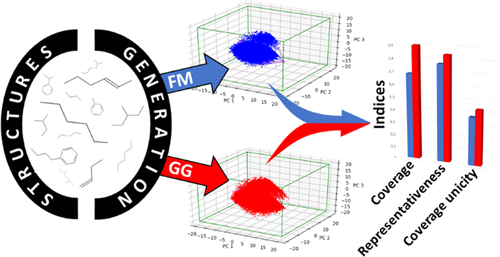当前位置:
X-MOL 学术
›
J. Chem. Inf. Model.
›
论文详情
Our official English website, www.x-mol.net, welcomes your feedback! (Note: you will need to create a separate account there.)
Comparisons of Molecular Structure Generation Methods Based on Fragment Assemblies and Genetic Graphs
Journal of Chemical Information and Modeling ( IF 5.6 ) Pub Date : 2021-08-18 , DOI: 10.1021/acs.jcim.1c00803 Philippe Gantzer 1 , Benoit Creton 1 , Carlos Nieto-Draghi 1
Journal of Chemical Information and Modeling ( IF 5.6 ) Pub Date : 2021-08-18 , DOI: 10.1021/acs.jcim.1c00803 Philippe Gantzer 1 , Benoit Creton 1 , Carlos Nieto-Draghi 1
Affiliation

|
The use of quantitative structure–property relationships (QSPRs) helps in predicting molecular properties for several decades, while the automatic design of new molecular structures is still emerging. The choice of algorithms to generate molecules is not obvious and is related to several factors such as the desired chemical diversity (according to an initial dataset’s content) and the level of construction (the use of atoms, fragments, pattern-based methods). In this paper, we address the problem of molecular structure generation by revisiting two approaches: fragment-based methods (FMs) and genetic-based methods (GMs). We define a set of indices to compare generation methods on a specific task. New indices inform about the explored data space (coverage), compare how the data space is explored (representativeness), and quantifies the ratio of molecules satisfying requirements (generation specificity) without the use of a database composed of real chemicals as a reference. These indices were employed to compare generations of molecules fulfilling the desired property criterion, evaluated by QSPR.
中文翻译:

基于片段组装和遗传图的分子结构生成方法的比较
数十年来,定量结构-性质关系 (QSPR) 的使用有助于预测分子性质,而新分子结构的自动设计仍在出现。生成分子的算法的选择并不明显,它与多个因素有关,例如所需的化学多样性(根据初始数据集的内容)和构建水平(使用原子、片段、基于模式的方法)。在本文中,我们通过重新审视两种方法来解决分子结构生成的问题:基于片段的方法 (FM) 和基于遗传的方法 (GM)。我们定义了一组索引来比较特定任务的生成方法。新索引告知探索的数据空间(覆盖率),比较数据空间的探索方式(代表性),并在不使用由真实化学品组成的数据库作为参考的情况下量化满足要求(生成特异性)的分子的比率。这些指数用于比较满足所需特性标准的分子代,由 QSPR 评估。
更新日期:2021-09-27
中文翻译:

基于片段组装和遗传图的分子结构生成方法的比较
数十年来,定量结构-性质关系 (QSPR) 的使用有助于预测分子性质,而新分子结构的自动设计仍在出现。生成分子的算法的选择并不明显,它与多个因素有关,例如所需的化学多样性(根据初始数据集的内容)和构建水平(使用原子、片段、基于模式的方法)。在本文中,我们通过重新审视两种方法来解决分子结构生成的问题:基于片段的方法 (FM) 和基于遗传的方法 (GM)。我们定义了一组索引来比较特定任务的生成方法。新索引告知探索的数据空间(覆盖率),比较数据空间的探索方式(代表性),并在不使用由真实化学品组成的数据库作为参考的情况下量化满足要求(生成特异性)的分子的比率。这些指数用于比较满足所需特性标准的分子代,由 QSPR 评估。



























 京公网安备 11010802027423号
京公网安备 11010802027423号